Forty-year pollution history of microplastics in the largest marginal sea of the western Pacific
Affiliations | Corresponding Author | Cite as | Funding information- Share this article





Article views:1,531Cumulative count of HTML views and PDF downloads.
- Download Citation
- Rights & Permissions
top
Abstract
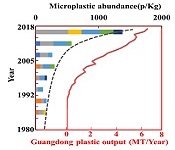
Figures and Tables
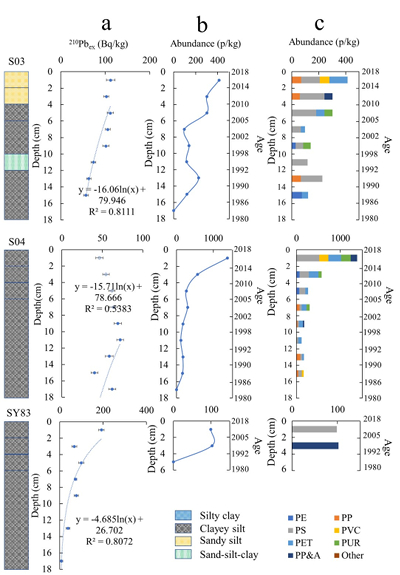 Figure 1 The profiles of excess 210Pb, microplastic abundance and microplastic composition of sediment cores at S03, S04, and SY83 stations (the profiles of sediment cores at SY81, SY87, and SQW43 stations are shown in Fig. S-1). (a) Excess 210Pb profile. The sediment rates were calculated according to the gradient of the excess 210Pb as a function of the depth. (b) Microplastic abundance (pieces per kg dry weight). (c) Microplastic composition. PE-polyethylene, PP-polypropylene, PS-polystyrene, PVC-polyvinyl chloride, PET-polyethylene terephthalate, PUR-polyurethane, PP&A includes polyester, polyamide, rayon and acrylic. | 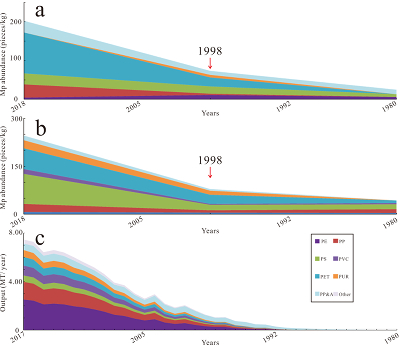 Figure 2 Microplastic abundance and composition in the northern SCS and the primary plastic output of Guangdong plastics industries. (a) Microplastic abundance and composition in Xisha Trough during 1980-2018. (b) Microplastic abundance and composition in the continental shelf during 1980-2018. (c) Output and composition of primary plastic during 1980-2017. The output data origin from the National Bureau of Statics of China, Annual Data of Guangdong Province (http://data.stats.gov.cn/easyquery.htm?cn=C01). The composition of primary plastics was calculated according to Geyer et al. (2017). PE-polyethylene, PP-polypropylene, PS-polystyrene, PVC-polyvinyl chloride, PET-polyethylene terephthalate, PUR-polyurethane, PP&A includes polyester, polyamide, rayon and acrylic. |  Figure 3 Contour maps of microplastic abundance (pieces/kg) in the sediments of the northern SCS. (a) The sample location of the study area (details in Table S-1). (b) Microplastic abundance in 1980-1992. (c) Microplastic abundance in 1992-2005. (d) Microplastic abundance in 2005-2018. The red rectangle in (a) shows the position of a large dump of plastics found by Peng et al. (2019). The black arrows indicate the Yuedong coastal current, while red arrows are for winter surface circulation pathways of the northern SCS that may potentially influence the transportation of microplastics in the water column of the continental shelf (Fang et al., 1998). |
| Figure 1 | Figure 2 | Figure 3 |
top
Letter
Plastics are widely used today because they are unmatched by any competing materials used in packaging or construction (Andrady and Neal, 2009
Andrady, A.L., Neal, M.A. (2009) Applications and societal benefits of plastics. Philosophical Transactions of the Royal Society B: Biological Sciences 364, 1977-1984.
). The global annual production of plastics rapidly increased from about 2 million tonnes (MT) in 1950 to 420 MT in 2017 (Geyer et al., 2017Geyer, R., Jambeck, J.R., Law, K.L. (2017) Production, use, and fate of all plastics ever made. Science Advances 3, doi: 10.1126/sciadv.1700782.
; Plastics Europe, 2018Plastics Europe (2018) Plastics—The Facts 2018: An Analysis of European Plastics Production, Demand and Waste Data. Downloaded from https://www.plasticseurope.org/application/files/6315/4510/9658/Plastics_the_facts_2018_AF_web.pdf.
). It is estimated that plastic waste could increase to 155-265 MT per year by 2060, the majority of which would eventually enter the ocean (Lebreton and Andrady, 2019Lebreton, L., Andrady, A. (2019) Future scenarios of global plastic waste generation and disposal. Palgrave Communications 5, 1-11.
). Plastic debris has been reported from the sea surface, water column, seabed and marine biota (Galgani et al., 1996Galgani, F., Souplet, A., Cadiou, Y. (1996) Accumulation of debris on the deep sea floor off the French Mediterranean coast. Marine Ecology Progress Series 142, 225-234.
; Kukulka et al., 2012Kukulka, T., Proskurowski, G., Morét-Ferguson, S., Meyer, D.W., Law, K. L. (2012) The effect of wind mixing on the vertical distribution of buoyant plastic debris. Geophysical Research Letters 39, L07601, doi: 10.1029/2012GL051116.
; Law et al., 2010Law, K. L., Morét-Ferguson, S., Maximenko, N.A., Proskurowski, G., Peacock, E.E., Hafner, J., Reddy, C.M. (2010) Plastic accumulation in the North Atlantic subtropical gyre. Science 329, 1185-1188.
; Goldstein et al., 2012Goldstein, M. C., Rosenberg, M., Cheng, L. (2012) Increased oceanic microplastic debris enhances oviposition in an endemic pelagic insect. Biology Letters 8, 817-820, doi: 10.1098/rsbl.2012.0298.
; Gall and Thomson, 2015Gall, S.C., Thompson, R.C. (2015) The impact of debris on marine life. Marine Pollution Bulletin 92, 170-179.
). Under the influence of light, mechanical abrasion, waves, temperature fluctuations, and possible biodegradation, plastics fragment into smaller particles with sizes less than 5 mm, termed as microplastic (Singh and Sharma, 2008Singh, B., Sharma, N. (2008) Mechanistic implications of plastic degradation. Polymer Degradation and Stability 93, 561-584.
; Arthur et al., 2009Arthur, C., Baker, J., Bamford, H. (Eds.) (2009) Proceedings of the International Research Workshop on the Occurrence, Effects, and Fate of Microplastic Marine Debris. NOAA Technical Memorandum NOS-OR&R-30.
). Most microplastics may eventually sink into the seafloor (Thompson et al., 2004Thompson, R.C., Olsen, Y., Mitchell, R.P., Davis, A., Rowland, S.J., John, A.W., Russell, A.E. (2004) Lost at sea: where is all the plastic? Science 304, 838-838.
; Claessens et al., 2011Claessens, M., De Meester, S., Van Landuyt, L., De Clerck, K., Janssen, C.R. (2011) Occurrence and distribution of microplastics in marine sediments along the Belgian coast. Marine Pollution Bulletin 62, 2199-2204.
; Woodall et al., 2014Woodall, L.C., Sanchez-Vidal, A., Canals, M., Paterson, G.L., Coppock, R., Sleight, V., Calafat, A., Rogers, D.A., Narayanaswamy, E.B., Thompson, R.C. (2014) The deep sea is a major sink for microplastic debris. Royal Society Open Science 1, doi: 10.1098/rsos.140317.
; Bergmann et al., 2017Bergmann, M., Wirzberger, V., Krumpen, T., Lorenz, C., Primpke, S., Tekman, M.B., Gerdts, G. (2017) High Quantities of Microplastic in Arctic Deep-Sea Sediments from the HAUSGARTEN Observatory. Environmental Science & Technology 51, 11000-11010.
; Peng et al., 2018Peng, X., Chen, M., Chen, S., Dasgupta, S., Xu, H., Ta, K., Li, J., Li, Guo, Z., Bai, S. (2018) Microplastics contaminate the deepest part of the world’s ocean. Geochemical Perspectives Letters 9, 1-5.
) and accumulate over time in the sedimentary sequence (Matsuguma et al., 2017Matsuguma, Y., Takada, H., Kumata, H., Kanke, H., Sakurai, S., Suzuki, T., Itoh, M., Okazaki, Y., Boonyatumanond, R., Zakaria, M.P., Weerts, S., Newman, B. (2017) Microplastics in sediment cores from Asia and Africa as indicators of temporal trends in plastic pollution. Archives of Environmental Contamination and Toxicology 73, 230-239.
; Martin et al., 2017Martin, J., Lusher, A., Thompson, R.C., Morley, A. (2017) The deposition and accumulation of microplastics in marine sediments and bottom water from the Irish continental shelf. Scientific Reports 7, doi: 10.1038/s41598-017-11079-2.
). Yet, the pollution history of microplastics documented in these sediments is still poorly understood. So far little is known about when and how microplastics accumulated in marine sediments in the past, creating a hiatus in the evaluation, prevention, and control of plastic pollutions.The South China Sea (SCS) is the largest marginal sea of the western Pacific where active land-sea interaction exists. The continental shelf of the northern SCS with a water depth of less than 500 m is the convergence point of several big rivers in south China, such as Xijiang, Dongjiang, Zhujiang, Hanjiang, Moyangjiang, and Jianjiang. The first four fall within the twenty most polluting rivers, as predicted by the global river plastic input model (Lebreton et al., 2017
Lebreton, L.C.M., Joost, V.D.Z., Damsteeg, J.W., Slat, B., Andrady, A., Reisser, J. (2017) River plastic emissions to the world’s oceans. Nature Communications 8, 15611.
). The Xisha Trough of the northern SCS extends east-west and deepens eastwards from 1500 to 3400 m (Qiu et al., 2001Qiu, X., Ye, S., Wu, S., Shi, X., Zhou, D., Xia, K., Flueh, E.R. (2001) Crustal structure across the Xisha trough, northwestern South China Sea. Tectonophysics 341, 179-193.
). In the western flank of the trough, there is a series of 19 tributary submarine canyons named Xisha Canyon. All the submarine canyons in the northern SCS slope extend from NE- and NW-trending directions (Hui et al., 2019Hui, G., Li, S., Guo, L., Somerville, I.D., Wang, P., Wang, Q. (2019) Mechanisms of submarine canyon formation on the northern continental slope of the South China Sea. Geological Journal 54, 3389-3403.
). Large plastics dumps were found to occur in these submarine canyons (Peng et al., 2019Peng, X., Dasgupta, S., Zhong, G., Du, M., Xu, H., Chen, M., Chen, S., Ta, K., Li, J. (2019) Large debris dumps in the northern South China Sea. Marine Pollution Bulletin 142, 164-168.
). However, the distribution, source, migration, and pollution history of microplastics in the sediments of the northern SCS are still poorly understood.210Pb dating has been employed in a variety of studies in marine sediments to study environmental changes during the last 100 years (Li, 1988
Li, F. (1988) Determination of recent sedimentation rates by 210Pb method in the South China Sea. Marine Sciences 3, 64-66. (In Chinese with English Abstract).
; Chung et al., 2004Chung, Y., Chang, H.C., Hung, G.W. (2004) Particulate flux and 210Pb determined on the sediment trap and core samples from the northern South China Sea. Continental Shelf Research 24, 673-691.
; Sanchez-Cabeza and Ruiz-Fernández, 2012Sanchez-Cabeza, J.A., Ruiz-Fernández, A.C. (2012) 210Pb sediment radiochronology: an integrated formulation and classification of dating models. Geochimica et Cosmochimica Acta 82, 183-200.
). Using a manned submersible Shenhaiyongshi and a box sampler, we recovered undisturbed sediment cores for 210Pb dating from six stations in the northern SCS (Fig. 1 and Fig. S-1). The ages of five more stations were also evaluated according to Li (1988)Li, F. (1988) Determination of recent sedimentation rates by 210Pb method in the South China Sea. Marine Sciences 3, 64-66. (In Chinese with English Abstract).
(Table S-2). The sediment cores SY83 from the Xisha Trough were dated back to 1980 at 4 to 6 cm, while the cores S03 and S04 from the nearshore stations dated back to 1980 at depth of 16 to 18 cm owing to their high sedimentation rates (Fig. 1 and Table S-3). The highest microplastic abundance commonly occurred at the surface sediments at all stations. Sedimentary profiles were clearly characterised by a general declining trend of microplastic abundance with an increase of depths and ages. Regression analysis was employed to estimate the pollution situation at nearshore stations over the next ten years. The results estimated that the microplastic abundances would reach 848 pieces/kg and 3054 pieces/kg by 2028 at stations S03 and S04, nearly two times as much as those in 2018 (Fig. S-2).
Figure 1 The profiles of excess 210Pb, microplastic abundance and microplastic composition of sediment cores at S03, S04, and SY83 stations (the profiles of sediment cores at SY81, SY87, and SQW43 stations are shown in Fig. S-1). (a) Excess 210Pb profile. The sediment rates were calculated according to the gradient of the excess 210Pb as a function of the depth. (b) Microplastic abundance (pieces per kg dry weight). (c) Microplastic composition. PE-polyethylene, PP-polypropylene, PS-polystyrene, PVC-polyvinyl chloride, PET-polyethylene terephthalate, PUR-polyurethane, PP&A includes polyester, polyamide, rayon and acrylic.
Statistical analysis of the stations in Xisha Trough and the continental shelf also showed microplastic abundances dramatically increased from 1980 to 2018 (Fig. 2). In addition, the abundance of different types of microplastic exhibited an increasing trend from 1980 to 2018 as well. Intriguingly, a strong increase of microplastic abundance occurred in about 1998, representing an important breakpoint for plastic production and consumption (Fig. 2a,b). In the Guangdong province of China, plastic production growth began in the 1980s. Consequently, the output of plastic increased every year and reached 7.49 MT in 2017, which was hundreds of times higher than 0.02 MT in 1980. The rising output of plastic in local industries is well in line with the increasing microplastic abundance in sediment cores over time. In addition to microplastic abundance, the microplastic composition varies in the sedimentary profiles at some stations (Fig. 1c), which may indicate a change in the usage of primary polymer type during different periods.

Figure 2 Microplastic abundance and composition in the northern SCS and the primary plastic output of Guangdong plastic industries. (a) Microplastic abundance and composition in Xisha Trough during 1980-2018. (b) Microplastic abundance and composition in the continental shelf during 1980-2018. (c) Output and composition of primary plastic during 1980-2017. The output data origin from the National Bureau of Statics of China, Annual Data of Guangdong Province (http://data.stats.gov.cn/easyquery.htm?cn=C01). The composition of primary plastic was calculated according to Geyer et al. (2017)
Geyer, R., Jambeck, J.R., Law, K.L. (2017) Production, use, and fate of all plastics ever made. Science Advances 3, doi: 10.1126/sciadv.1700782.
. PE-polyethylene, PP-polypropylene, PS-polystyrene, PVC-polyvinyl chloride, PET-polyethylene terephthalate, PUR-polyurethane, PP&A includes polyester, polyamide, rayon and acrylic.210Pb dating data were used to reconstruct the regional pollution history of microplastics in the northern SCS (Fig. 3). The results showed the variability of the contamination situation in different areas and the movement of the microplastic depocentre in different periods. During 1980-1992, microplastic abundances ranged from 0 to 169 pieces/kg dry weight, with a mean abundance of 34 pieces/kg dry weight. The depocentre was identified at the shelf station S04 close to the Zhujiang Delta region, at station SQW31 in the upper reaches of the Xisha Trough, and at station SY82 in the Xisha Canyon (Fig. 3b). From 1992 to 2005, microplastic abundance rose to some extent, with an average of 76 pieces/kg dry weight. Although S04 still remained an active depocentre, new depocentres, SQW32 and SQW38, emerged in the middle reach of the Xisha Trough (Fig. 3c). During 2005-2018, microplastics in the sediments increased dramatically, reaching a mean abundance of 224 pieces/kg dry weight, which was about six times that in the 1980s. While S04 and SQW32 still remained as active depocentres, SY85 at the lower reach of the Xisha Trough appeared as a new depocentre (Fig. 3d). The shift of the microplastic depocentres with time, from the continental shelf to the Xisha Canyon, and then to Xisha Trough, can be identified. These results provided valuable information on how the microplastic contaminated marginal sea migrated stage by stage in the past 40 years.
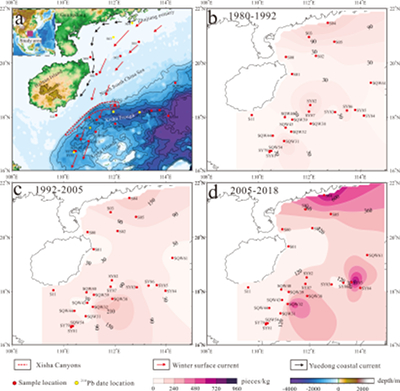
Figure 3 Contour maps of microplastic abundance (pieces/kg) in the sediments of the northern SCS. (a) The sample location of the study area (details in Table S-1). (b) Microplastic abundance in 1980-1992. (c) Microplastic abundance in 1992-2005. (d) Microplastic abundance in 2005-2018. The red rectangle in (a) shows the position of a large dump of plastics found by Peng et al. (2019)
Peng, X., Dasgupta, S., Zhong, G., Du, M., Xu, H., Chen, M., Chen, S., Ta, K., Li, J. (2019) Large debris dumps in the northern South China Sea. Marine Pollution Bulletin 142, 164-168.
. The black arrows indicate the Yuedong coastal current, while red arrows are for winter surface circulation pathways of the northern SCS that may potentially influence the transportation of microplastics in the water column of the continental shelf (Fang et al., 1998Fang, G.H., Fang, W.D., Fang, Y., Wang, K. (1998) A survey of studies on the South China Sea upper ocean circulation. Acta Oceanographica Taiwanica 37, 1-16.
).Since the 1980s, the nearshore station S04 in the northern SCS has continued to be a microplastic depocentre. The reason for this is that it receives a large amount of plastic debris discharge from several big rivers, such as Dongjiang, Xijiang, and Zhujiang (Cai et al., 2018
Cai, M., He, H., Liu, M., Li, S., Tang, G., Wang, W., Hu, J. (2018) Lost but can't be neglected: Huge quantities of small microplastics hide in the South China Sea. Science of the Total Environment 633, 1206-1216.
). Wastewater discharge, stormwater runoff and industrial activities were possible sources of microplastics into the rivers in this area (Zhang et al., 2018Zhang, K., Shi, H., Peng, J., Wang, Y., Xiong, X., Wu, C., Lam, P.K. (2018) Microplastic pollution in China's inland water systems: A review of findings, methods, characteristics, effects, and management. Science of the Total Environment 630, 1641-1653.
). The other reason is attributed to heavy commercial fishing and shipping activities discharging a large number of plastic wastes (Peng et al., 2019Peng, X., Dasgupta, S., Zhong, G., Du, M., Xu, H., Chen, M., Chen, S., Ta, K., Li, J. (2019) Large debris dumps in the northern South China Sea. Marine Pollution Bulletin 142, 164-168.
; Zhang et al., 2019Zhang, C., Zhou, H., Cui, Y., Wang, C., Li, Y., Zhang, D. (2019) Microplastics in offshore sediment in the yellow Sea and east China Sea, China. Environmental Pollution 244, 827-833.
). Once entering the coast, a part of microplastics (in particular those with low specific density such as polypropylene and polyethylene that have been commonly identified in the whole region in this study), could be delivered by marine currents for example, the Guangdong coastal current and the winter surface current of the northern SCS, to the continental shelf. With time, these microplastics eventually settled on the seafloor of the shelf due to colonisation by organisms and the aggregation with organic debris and particles (Zarfl and Matthies, 2010Zarfl, C., Matthies, M. (2010) Are marine plastic particles transport vectors for organic pollutants to the Arctic? Marine Pollution Bulletin 60, 1810-1814.
; Katija et al., 2017Katija, K., Choy, C.A., Sherlock, R.E., Sherman, A.D., Robison, B.H. (2017) From the surface to the seafloor: how giant larvaceans transport microplastics into the deep sea. Science Advance 3, e1700715.
). Once microplastics reached the seabed, they may be swept off the continental shelf by littoral drift (Paull et al., 2010Paull, C.K., Ussler III, W., Caress, D.W., Lundsten, E., Covault, J.A., Maier, K.L., Xu, J., Augenstein, S. (2010) Origins of large crescent-shaped bedforms within the axial channel of Monterey Canyon, offshore California. Geosphere 6, 755-774.
) or bottom currents into the Xisha Canyon where a new depocentre formed. However, unlike most of the large plastic items which can be trapped in the canyon (Peng et al., 2019Peng, X., Dasgupta, S., Zhong, G., Du, M., Xu, H., Chen, M., Chen, S., Ta, K., Li, J. (2019) Large debris dumps in the northern South China Sea. Marine Pollution Bulletin 142, 164-168.
), microplastics might continue to be transported by the bottom current along the seabed and arrive in the low upper reach of the Xisha Trough, leading to the formation of a new depocentre in the last ten years. These results suggested that submarine canyons and troughs acted as important pathways for the transportation of microplastics from the continental shelf to the deep sea (Pham et al., 2014Pham, C.K., Ramirez-Llodra, E., Alt, C.H.S., Amaro, T., Bergmann, M., Canals, M., Company, J.B., Davies, J., Duineveld, G., Galgani, F., Howell, K.L., Huvenne, V.A.I., Isidro, E., Jones, D.O.B., Lastras, G., Morato, T., Gomes-Pereira, J.N., Purser, A., Stewart, H., Tojeira, I., Tubau, X., Van Rooij, D., Tyler, P.A. (2014) Marine litter distribution and density in European seas, from the shelves to deep basins. PLoS One 9, doi: 10.1371/journal.pone.0095839.
).The marginal sea is an important convergence point of land-based and marine-based microplastics (Zhang et al., 2019
Zhang, C., Zhou, H., Cui, Y., Wang, C., Li, Y., Zhang, D. (2019) Microplastics in offshore sediment in the yellow Sea and east China Sea, China. Environmental Pollution 244, 827-833.
), making it an ideal area to study the history of microplastics. Our results showed that the sediments of the marginal sea, especially the nearshore sediments, could preserve a complete record of microplastic contamination history. Pb isotope chronology may serve as a useful tool for reconstructing the microplastic pollution history in marginal sea sediments worldwide. In this study, we provided the first full view of the spatial and temporal variation of microplastic abundances and highlighted the situation of microplastic pollution in the northern SCS. The microplastic abundance in the SCS sediments has reached its highest level in 2018 and will likely continue to increase dramatically during the next decades if no control measures are taken. More strict laws and regulations for the usage and production of plastics are needed to be implemented to avoid further harmful microplastics entering the oceans.top
Acknowledgements
We are very grateful to the pilots and crew of the R/V Tansuoyihao with manned submersible Shenhaiyongshi and R/V Zhanke 10 for their professional service during the cruises. Funding for this study was provided by the National Key Research and Development Plan of China (2016YFC0304900, 2018YFC0309802, 2017YFC0306702, 2016YFC0300503) and the National Natural Science Foundation of China (41602345).
Editor: Eric H. Oelkers
top
References
Andrady, A.L., Neal, M.A. (2009) Applications and societal benefits of plastics. Philosophical Transactions of the Royal Society B: Biological Sciences 364, 1977-1984.
 Show in context
Show in context Plastics are widely used today because they are unmatched by any competing materials used in packaging or construction (Andrady and Neal, 2009).
View in article
Arthur, C., Baker, J., Bamford, H. (Eds.) (2009) Proceedings of the International Research Workshop on the Occurrence, Effects, and Fate of Microplastic Marine Debris. NOAA Technical Memorandum NOS-OR&R-30.
 Show in context
Show in context Under the influence of light, mechanical abrasion, waves, temperature fluctuations, and possible biodegradation, plastics fragment into smaller particles with sizes less than 5 mm, termed as microplastic (Singh and Sharma, 2008; Arthur et al., 2009).
View in article
Bergmann, M., Wirzberger, V., Krumpen, T., Lorenz, C., Primpke, S., Tekman, M.B., Gerdts, G. (2017) High Quantities of Microplastic in Arctic Deep-Sea Sediments from the HAUSGARTEN Observatory. Environmental Science & Technology 51, 11000-11010.
 Show in context
Show in context Most microplastics may eventually sink into the seafloor (Thompson et al., 2004; Claessens et al., 2011; Woodall et al., 2014; Bergmann et al., 2017; Peng et al., 2018) and accumulate over time in the sedimentary sequence (Matsuguma et al., 2017; Martin et al., 2017).
View in article
Cai, M., He, H., Liu, M., Li, S., Tang, G., Wang, W., Hu, J. (2018) Lost but can't be neglected: Huge quantities of small microplastics hide in the South China Sea. Science of the Total Environment 633, 1206-1216.
 Show in context
Show in context The reason for this is that it receives a large amount of plastic debris discharge from several big rivers, such as Dongjiang, Xijiang, and Zhujiang (Cai et al., 2018).
View in article
Chung, Y., Chang, H.C., Hung, G.W. (2004) Particulate flux and 210Pb determined on the sediment trap and core samples from the northern South China Sea. Continental Shelf Research 24, 673-691.
 Show in context
Show in context 210Pb dating has been employed in a variety of studies in marine sediments to study environmental changes during the last 100 years (Li, 1988; Chung et al., 2004; Sanchez-Cabeza and Ruiz-Fernández, 2012).
View in article
Claessens, M., De Meester, S., Van Landuyt, L., De Clerck, K., Janssen, C.R. (2011) Occurrence and distribution of microplastics in marine sediments along the Belgian coast. Marine Pollution Bulletin 62, 2199-2204.
 Show in context
Show in context Most microplastics may eventually sink into the seafloor (Thompson et al., 2004; Claessens et al., 2011; Woodall et al., 2014; Bergmann et al., 2017; Peng et al., 2018) and accumulate over time in the sedimentary sequence (Matsuguma et al., 2017; Martin et al., 2017).
View in article
Fang, G.H., Fang, W.D., Fang, Y., Wang, K. (1998) A survey of studies on the South China Sea upper ocean circulation. Acta Oceanographica Taiwanica 37, 1-16.
 Show in context
Show in context Figure 3 [...] The black arrows indicate the Yuedong coastal current, while red arrows are for winter surface circulation pathways of the northern SCS that may potentially influence the transportation of microplastics in the water column of the continental shelf (Fang et al., 1998).
View in article
Galgani, F., Souplet, A., Cadiou, Y. (1996) Accumulation of debris on the deep sea floor off the French Mediterranean coast. Marine Ecology Progress Series 142, 225-234.
 Show in context
Show in context Plastic debris has been reported from the sea surface, water column, seabed and marine biota (Galgani et al., 1996; Kukulka et al., 2012; Law et al., 2010; Goldstein et al., 2012; Gall and Thomson, 2015).
View in article
Gall, S.C., Thompson, R.C. (2015) The impact of debris on marine life. Marine Pollution Bulletin 92, 170-179.
 Show in context
Show in context Plastic debris has been reported from the sea surface, water column, seabed and marine biota (Galgani et al., 1996; Kukulka et al., 2012; Law et al., 2010; Goldstein et al., 2012; Gall and Thomson, 2015).
View in article
Geyer, R., Jambeck, J.R., Law, K.L. (2017) Production, use, and fate of all plastics ever made. Science Advances 3, doi: 10.1126/sciadv.1700782.
 Show in context
Show in context The global annual production of plastics rapidly increased from about 2 million tonnes (MT) in 1950 to 420 MT in 2017 (Geyer et al., 2017; Plastics Europe, 2018).
View in article
Figure 2 [...] The composition of primary plastic was calculated according to Geyer et al. (2017).
View in article
Goldstein, M. C., Rosenberg, M., Cheng, L. (2012) Increased oceanic microplastic debris enhances oviposition in an endemic pelagic insect. Biology Letters 8, 817-820, doi: 10.1098/rsbl.2012.0298.
 Show in context
Show in context Plastic debris has been reported from the sea surface, water column, seabed and marine biota (Galgani et al., 1996; Kukulka et al., 2012; Law et al., 2010; Goldstein et al., 2012; Gall and Thomson, 2015).
View in article
Hui, G., Li, S., Guo, L., Somerville, I.D., Wang, P., Wang, Q. (2019) Mechanisms of submarine canyon formation on the northern continental slope of the South China Sea. Geological Journal 54, 3389-3403.
 Show in context
Show in context All the submarine canyons in the northern SCS slope extend from NE- and NW-trending directions (Hui et al., 2019).
View in article
Katija, K., Choy, C.A., Sherlock, R.E., Sherman, A.D., Robison, B.H. (2017) From the surface to the seafloor: how giant larvaceans transport microplastics into the deep sea. Science Advance 3, e1700715.
 Show in context
Show in context With time, these microplastics eventually settled on the seafloor of the shelf due to colonisation by organisms and the aggregation with organic debris and particles (Zarfl and Matthies, 2010; Katija et al., 2017).
View in article
Kukulka, T., Proskurowski, G., Morét-Ferguson, S., Meyer, D.W., Law, K. L. (2012) The effect of wind mixing on the vertical distribution of buoyant plastic debris. Geophysical Research Letters 39, L07601, doi: 10.1029/2012GL051116.
 Show in context
Show in context Plastic debris has been reported from the sea surface, water column, seabed and marine biota (Galgani et al., 1996; Kukulka et al., 2012; Law et al., 2010; Goldstein et al., 2012; Gall and Thomson, 2015).
View in article
Law, K. L., Morét-Ferguson, S., Maximenko, N.A., Proskurowski, G., Peacock, E.E., Hafner, J., Reddy, C.M. (2010) Plastic accumulation in the North Atlantic subtropical gyre. Science 329, 1185-1188.
 Show in context
Show in context Plastic debris has been reported from the sea surface, water column, seabed and marine biota (Galgani et al., 1996; Kukulka et al., 2012; Law et al., 2010; Goldstein et al., 2012; Gall and Thomson, 2015).
View in article
Lebreton, L., Andrady, A. (2019) Future scenarios of global plastic waste generation and disposal. Palgrave Communications 5, 1-11.
 Show in context
Show in context It is estimated that plastic waste could increase to 155-265 MT per year by 2060, the majority of which would eventually enter the ocean (Lebreton and Andrady, 2019).
View in article
Lebreton, L.C.M., Joost, V.D.Z., Damsteeg, J.W., Slat, B., Andrady, A., Reisser, J. (2017) River plastic emissions to the world’s oceans. Nature Communications 8, 15611.
 Show in context
Show in context The first four fall within the twenty most polluting rivers, as predicted by the global river plastic input model (Lebreton et al., 2017).
View in article
Li, F. (1988) Determination of recent sedimentation rates by 210Pb method in the South China Sea. Marine Sciences 3, 64-66. (In Chinese with English Abstract).
 Show in context
Show in context 210Pb dating has been employed in a variety of studies in marine sediments to study environmental changes during the last 100 years (Li, 1988; Chung et al., 2004; Sanchez-Cabeza and Ruiz-Fernández, 2012).
View in article
The ages of five more stations were also evaluated according to Li (1988) (Table S-2).
View in article
Martin, J., Lusher, A., Thompson, R.C., Morley, A. (2017) The deposition and accumulation of microplastics in marine sediments and bottom water from the Irish continental shelf. Scientific Reports 7, doi: 10.1038/s41598-017-11079-2.
 Show in context
Show in context Most microplastics may eventually sink into the seafloor (Thompson et al., 2004; Claessens et al., 2011; Woodall et al., 2014; Bergmann et al., 2017; Peng et al., 2018) and accumulate over time in the sedimentary sequence (Matsuguma et al., 2017; Martin et al., 2017).
View in article
Matsuguma, Y., Takada, H., Kumata, H., Kanke, H., Sakurai, S., Suzuki, T., Itoh, M., Okazaki, Y., Boonyatumanond, R., Zakaria, M.P., Weerts, S., Newman, B. (2017) Microplastics in sediment cores from Asia and Africa as indicators of temporal trends in plastic pollution. Archives of Environmental Contamination and Toxicology 73, 230-239.
 Show in context
Show in context Most microplastics may eventually sink into the seafloor (Thompson et al., 2004; Claessens et al., 2011; Woodall et al., 2014; Bergmann et al., 2017; Peng et al., 2018) and accumulate over time in the sedimentary sequence (Matsuguma et al., 2017; Martin et al., 2017).
View in article
Paull, C.K., Ussler III, W., Caress, D.W., Lundsten, E., Covault, J.A., Maier, K.L., Xu, J., Augenstein, S. (2010) Origins of large crescent-shaped bedforms within the axial channel of Monterey Canyon, offshore California. Geosphere 6, 755-774.
 Show in context
Show in context Once microplastics reached the seabed, they may be swept off the continental shelf by littoral drift (Paull et al., 2010) or bottom currents into the Xisha Canyon where a new depocentre formed.
View in article
Peng, X., Chen, M., Chen, S., Dasgupta, S., Xu, H., Ta, K., Li, J., Li, Guo, Z., Bai, S. (2018) Microplastics contaminate the deepest part of the world’s ocean. Geochemical Perspectives Letters 9, 1-5.
 Show in context
Show in context Most microplastics may eventually sink into the seafloor (Thompson et al., 2004; Claessens et al., 2011; Woodall et al., 2014; Bergmann et al., 2017; Peng et al., 2018) and accumulate over time in the sedimentary sequence (Matsuguma et al., 2017; Martin et al., 2017).
View in article
Peng, X., Dasgupta, S., Zhong, G., Du, M., Xu, H., Chen, M., Chen, S., Ta, K., Li, J. (2019) Large debris dumps in the northern South China Sea. Marine Pollution Bulletin 142, 164-168.
 Show in context
Show in context Large plastics dumps were found to occur in these submarine canyons (Peng et al., 2019).
View in article
Figure 3 [...] The red rectangle in (a) shows the position of a large dump of plastics found by Peng et al. (2019).
View in article
The other reason is attributed to heavy commercial fishing and shipping activities discharging a large number of plastic wastes (Peng et al., 2019; Zhang et al., 2019).
View in article
However, unlike most of the large plastic items which can be trapped in the canyon (Peng et al., 2019), microplastics might continue to be transported by the bottom current along the seabed and arrive in the low upper reach of the Xisha Trough, leading to the formation of a new depocentre in the last ten years.
View in article
Pham, C.K., Ramirez-Llodra, E., Alt, C.H.S., Amaro, T., Bergmann, M., Canals, M., Company, J.B., Davies, J., Duineveld, G., Galgani, F., Howell, K.L., Huvenne, V.A.I., Isidro, E., Jones, D.O.B., Lastras, G., Morato, T., Gomes-Pereira, J.N., Purser, A., Stewart, H., Tojeira, I., Tubau, X., Van Rooij, D., Tyler, P.A. (2014) Marine litter distribution and density in European seas, from the shelves to deep basins. PLoS One 9, doi: 10.1371/journal.pone.0095839.
 Show in context
Show in context These results suggested that submarine canyons and troughs acted as important pathways for the transportation of microplastics from the continental shelf to the deep sea (Pham et al., 2014).
View in article
Plastics Europe (2018) Plastics—The Facts 2018: An Analysis of European Plastics Production, Demand and Waste Data. Downloaded from https://www.plasticseurope.org/application/files/6315/4510/9658/Plastics_the_facts_2018_AF_web.pdf.
 Show in context
Show in context The global annual production of plastics rapidly increased from about 2 million tonnes (MT) in 1950 to 420 MT in 2017 (Geyer et al., 2017; Plastics Europe, 2018).
View in article
Qiu, X., Ye, S., Wu, S., Shi, X., Zhou, D., Xia, K., Flueh, E.R. (2001) Crustal structure across the Xisha trough, northwestern South China Sea. Tectonophysics 341, 179-193.
 Show in context
Show in context The Xisha Trough of the northern SCS extends east-west and deepens eastwards from 1500 to 3400 m (Qiu et al., 2001).
View in article
Sanchez-Cabeza, J.A., Ruiz-Fernández, A.C. (2012) 210Pb sediment radiochronology: an integrated formulation and classification of dating models. Geochimica et Cosmochimica Acta 82, 183-200.
 Show in context
Show in context 210Pb dating has been employed in a variety of studies in marine sediments to study environmental changes during the last 100 years (Li, 1988; Chung et al., 2004; Sanchez-Cabeza and Ruiz-Fernández, 2012).
View in article
Singh, B., Sharma, N. (2008) Mechanistic implications of plastic degradation. Polymer Degradation and Stability 93, 561-584.
 Show in context
Show in context Under the influence of light, mechanical abrasion, waves, temperature fluctuations, and possible biodegradation, plastics fragment into smaller particles with sizes less than 5 mm, termed as microplastic (Singh and Sharma, 2008; Arthur et al., 2009).
View in article
Thompson, R.C., Olsen, Y., Mitchell, R.P., Davis, A., Rowland, S.J., John, A.W., Russell, A.E. (2004) Lost at sea: where is all the plastic? Science 304, 838-838.
 Show in context
Show in context Most microplastics may eventually sink into the seafloor (Thompson et al., 2004; Claessens et al., 2011; Woodall et al., 2014; Bergmann et al., 2017; Peng et al., 2018) and accumulate over time in the sedimentary sequence (Matsuguma et al., 2017; Martin et al., 2017).
View in article
Woodall, L.C., Sanchez-Vidal, A., Canals, M., Paterson, G.L., Coppock, R., Sleight, V., Calafat, A., Rogers, D.A., Narayanaswamy, E.B., Thompson, R.C. (2014) The deep sea is a major sink for microplastic debris. Royal Society Open Science 1, doi: 10.1098/rsos.140317.
 Show in context
Show in context Most microplastics may eventually sink into the seafloor (Thompson et al., 2004; Claessens et al., 2011; Woodall et al., 2014; Bergmann et al., 2017; Peng et al., 2018) and accumulate over time in the sedimentary sequence (Matsuguma et al., 2017; Martin et al., 2017).
View in article
Zarfl, C., Matthies, M. (2010) Are marine plastic particles transport vectors for organic pollutants to the Arctic? Marine Pollution Bulletin 60, 1810-1814.
 Show in context
Show in context With time, these microplastics eventually settled on the seafloor of the shelf due to colonisation by organisms and the aggregation with organic debris and particles (Zarfl and Matthies, 2010; Katija et al., 2017).
View in article
Zhang, C., Zhou, H., Cui, Y., Wang, C., Li, Y., Zhang, D. (2019) Microplastics in offshore sediment in the yellow Sea and east China Sea, China. Environmental Pollution 244, 827-833.
 Show in context
Show in context The other reason is attributed to heavy commercial fishing and shipping activities discharging a large number of plastic wastes (Peng et al., 2019; Zhang et al., 2019).
View in article
The marginal sea is an important convergence point of land-based and marine-based microplastics (Zhang et al., 2019), making it an ideal area to study the history of microplastics.
View in article
Zhang, K., Shi, H., Peng, J., Wang, Y., Xiong, X., Wu, C., Lam, P.K. (2018) Microplastic pollution in China's inland water systems: A review of findings, methods, characteristics, effects, and management. Science of the Total Environment 630, 1641-1653.
 Show in context
Show in context Wastewater discharge, stormwater runoff and industrial activities were possible sources of microplastics into the rivers in this area (Zhang et al., 2018).
View in article
top
Supplementary Information
The Supplementary Information includes:
- Study Area
- Sampling and Analytical Methods
- Tables S-1 to S-3
- Figures S-1 and S-2
- Supplementary Information References
Download the Supplementary Information (PDF).
Figures and Tables
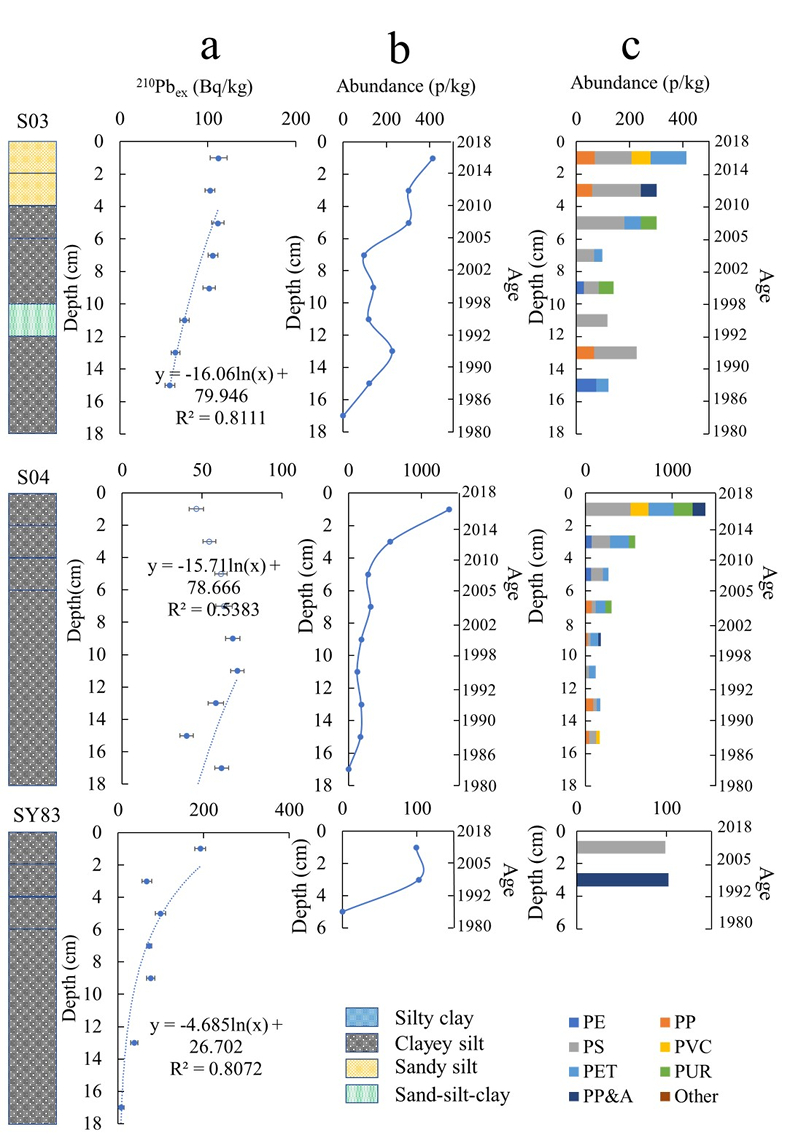
Figure 1 The profiles of excess 210Pb, microplastic abundance and microplastic composition of sediment cores at S03, S04, and SY83 stations (the profiles of sediment cores at SY81, SY87, and SQW43 stations are shown in Fig. S-1). (a) Excess 210Pb profile. The sediment rates were calculated according to the gradient of the excess 210Pb as a function of the depth. (b) Microplastic abundance (pieces per kg dry weight). (c) Microplastic composition. PE-polyethylene, PP-polypropylene, PS-polystyrene, PVC-polyvinyl chloride, PET-polyethylene terephthalate, PUR-polyurethane, PP&A includes polyester, polyamide, rayon and acrylic.
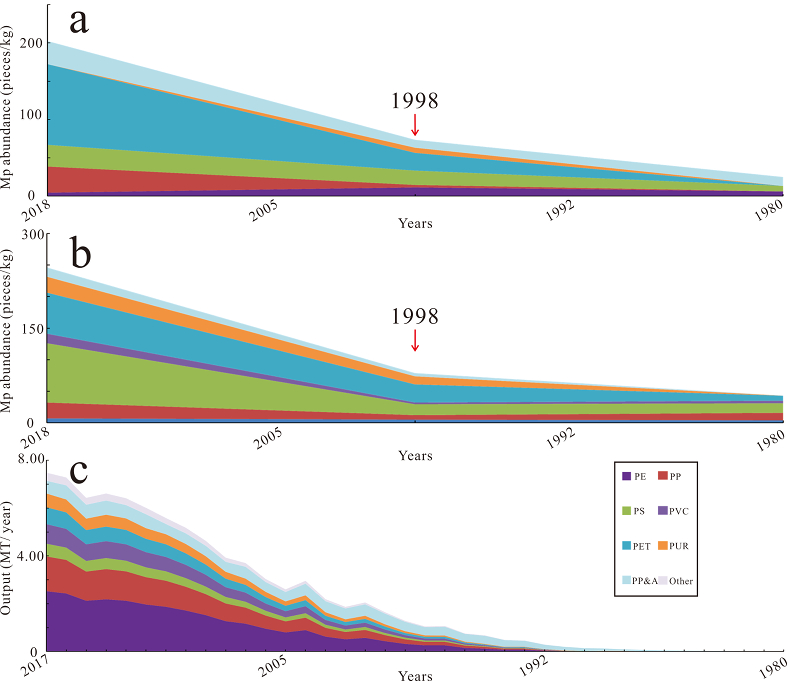
Figure 2 Microplastic abundance and composition in the northern SCS and the primary plastic output of Guangdong plastic industries. (a) Microplastic abundance and composition in Xisha Trough during 1980-2018. (b) Microplastic abundance and composition in the continental shelf during 1980-2018. (c) Output and composition of primary plastic during 1980-2017. The output data origin from the National Bureau of Statics of China, Annual Data of Guangdong Province (http://data.stats.gov.cn/easyquery.htm?cn=C01). The composition of primary plastic was calculated according to Geyer et al. (2017)
Geyer, R., Jambeck, J.R., Law, K.L. (2017) Production, use, and fate of all plastics ever made. Science Advances 3, doi: 10.1126/sciadv.1700782.
. PE-polyethylene, PP-polypropylene, PS-polystyrene, PVC-polyvinyl chloride, PET-polyethylene terephthalate, PUR-polyurethane, PP&A includes polyester, polyamide, rayon and acrylic.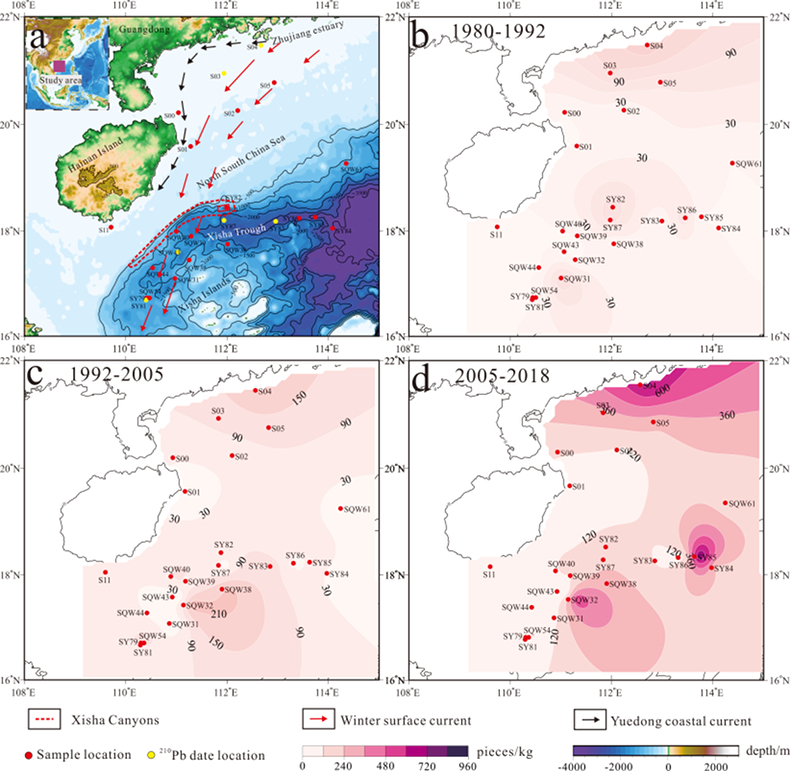
Figure 3 Contour maps of microplastic abundance (pieces/kg) in the sediments of the northern SCS. (a) The sample location of the study area (details in Table S-1). (b) Microplastic abundance in 1980-1992. (c) Microplastic abundance in 1992-2005. (d) Microplastic abundance in 2005-2018. The red rectangle in (a) shows the position of a large dump of plastics found by Peng et al. (2019)
Peng, X., Dasgupta, S., Zhong, G., Du, M., Xu, H., Chen, M., Chen, S., Ta, K., Li, J. (2019) Large debris dumps in the northern South China Sea. Marine Pollution Bulletin 142, 164-168.
. The black arrows indicate the Yuedong coastal current, while red arrows are for winter surface circulation pathways of the northern SCS that may potentially influence the transportation of microplastics in the water column of the continental shelf (Fang et al., 1998Fang, G.H., Fang, W.D., Fang, Y., Wang, K. (1998) A survey of studies on the South China Sea upper ocean circulation. Acta Oceanographica Taiwanica 37, 1-16.
).





